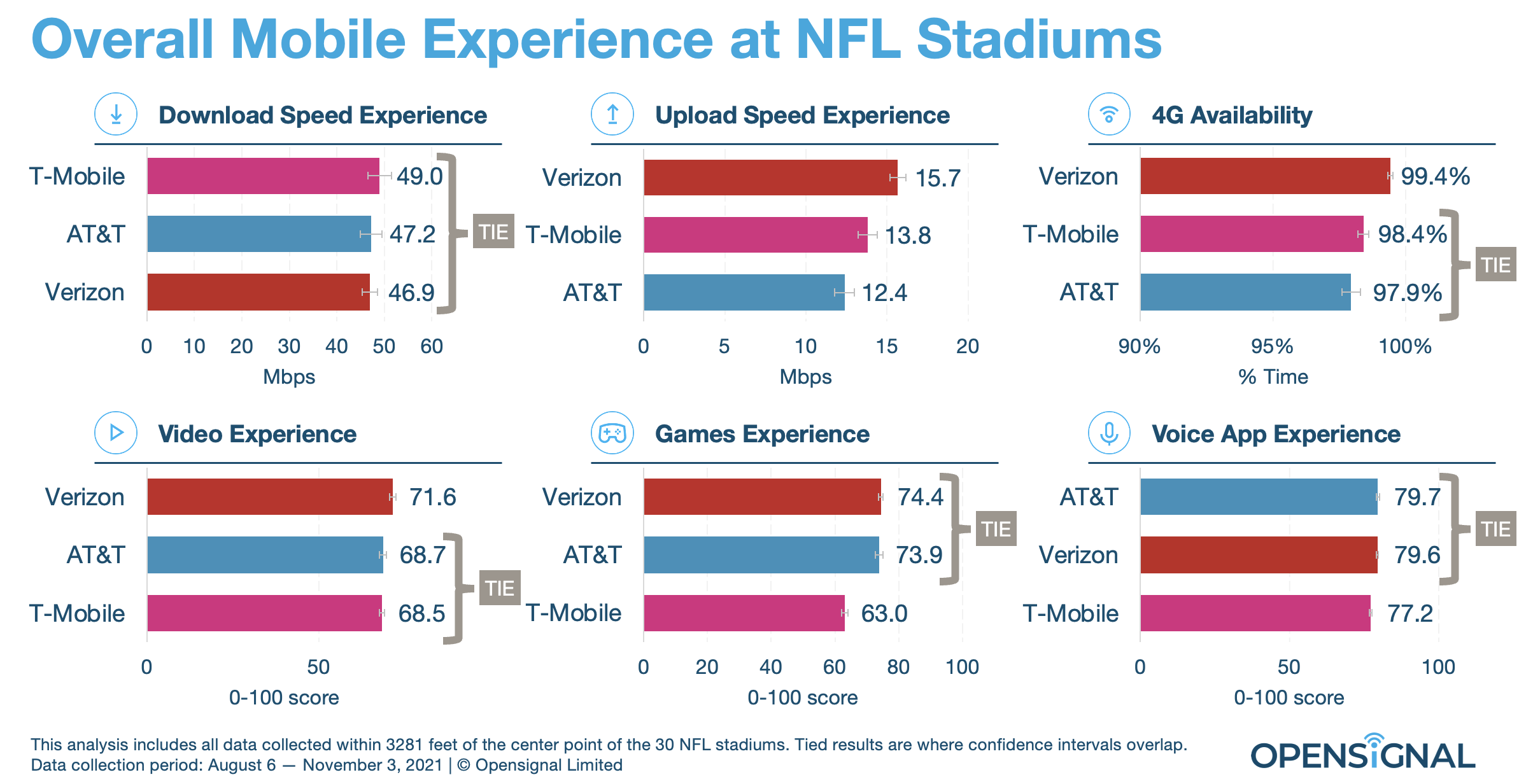When it comes to attendance at a sporting event, no sports league around the world has a larger average attendance than the National Football League (NFL), which attracted an average of 66,648 fans per game during the 2019 regular season. While the 2020 season featured a limited number of spectators following the pandemic, this year all stadiums are back to full capacity and fans can once again enjoy the full NFL gameday experience. However, as tens of thousands people crowd in stadiums sharing pictures and videos, watching highlights and instant replays, or streaming their experience online, these sporting events can prove an exceptional opportunity for U.S. carriers, but also a challenge for mobile network experience.
The 2021/2022 season is the first full season where there is widely available 5G from all three national mobile carriers. In this first Opensignal analysis at U.S. sports venues, we have analyzed our users’ 5G and overall mobile experience on the three national U.S. carriers during the 90 days starting on August 6 — the day of the first preseason NFL game — at and around the 30 U.S. stadiums that host the 32 NFL teams. We will analyze venues for other sports as their seasons proceed.

We found that our T-Mobile users enjoyed the highest 5G Availability of 50.5%. By comparison this was more than 15 percentage points higher than T-Mobile’s national 5G Availability score that we reported in October.
On the other hand, our users saw the fastest average 5G download speed of 320.7 Mbps using Verizon, which was more than twice as fast as our users’ average experience on T-Mobile (146 Mbps), and close to seven times faster than the speed our users experienced on AT&T (46.7 Mbps). Verizon 5G users also experienced the fastest average 5G upload speed of 26.1 Mbps, compared with 21.7 Mbps and 15.1 Mbps experienced by our T-Mobile and AT&T users, respectively. Our Verizon users enjoyed the highest score in 5G Games Experience and 5G Voice App Experience, while having a statistically similar experience with our T-Mobile users in Video Experience.
These 5G results are not surprising given Verizon’s focus on using millimeter-wave spectrum (mmWave) — marketed as Ultra Wideband — to connect high-traffic dense urban areas and venues. The carrier has now signed a 10-year partnership with the NFL. Verizon started deploying high-capacity mmWave 5G networks at these venues in 2019, and in September Verizon claimed its 5G Ultra Wideband service was available in parts of 25 out of a total of 30 NFL stadiums.
In Opensignal’s analysis we observed a limited use of mmWave 5G networks by our AT&T and T-Mobile users at the NFL stadiums and in their surroundings. AT&T reports that it has deployed its mmWave 5G service (5G+) in parts of at least 26 arenas and venues, including eight NFL stadiums. AT&T has also deployed dynamic spectrum sharing (DSS) technology that enables the carrier to use its spectrum bands for both 4G and 5G, but does not add hundreds of MHz of additional capacity like mmWave does. On the other hand, T-Mobile has pursued its 5G strategy of deploying its mid-band 5G spectrum band (2.5 GHz) across the country, but hasn’t focused as much as Verizon on using mmWave in arenas and venues — although T-Mobile reportedly deployed its full “layer cake” 5G in some areas, including the Raymond James Stadium ahead of the Super Bowl.

When we looked at our users’ overall experience at the 30 NFL stadiums we saw smaller differences across the three national U.S. carriers than what we observed for 5G. This is different to the 5G experience (above) because these results include all mobile network technology generations — 3G, 4G and 5G — and consider all mobile users, not just 5G users.
AT&T, T-Mobile and Verizon had a statistically tied Download Speed Experience with average speeds of 46.9-49 Mbps. By contrast, our Verizon users enjoyed the fastest Upload Speed Experience of 15.7 Mbps compared to T-Mobile (13.8 Mbps) and AT&T (12.4 Mbps). Our Verizon users also spent the highest amount of time (99.4%) with a 4G or better connection — 4G Availability — although our AT&T and T-Mobile users had a statistically tied experience which was quite close at 97.9% and 98.4% respectively.
Looking at Video Experience, our Verizon users saw the highest score of 71.6 points, while our AT&T and T-Mobile users saw statistically similar scores of 68.7 and 68.5 points respectively. On the other hand, AT&T and Verizon had a statistically tied score in both Games Experience and Voice App Experience, while our T-Mobile users’ experience was lower than that on the other two networks.
5G is especially important for stadiums because of the large numbers of users
As fans flock back to NFL stadiums to cheer and support their favorite teams and players, having a strong mobile experience is key for attendees to enjoy and share their experience with family and friends online. And, unlike the last season pre-Covid in 2019-2020, 5G is now commonplace across the U.S.
Opensignal data shows that the 5G experience was significantly better at NFL stadiums for our users on Verizon and T-Mobile than the overall mobile experience on those two carriers. For our AT&T users, 5G was better for upload speeds. However, it was our Verizon users that saw the largest improvements in their 5G mobile experience compared to the overall experience with Verizon.
Opensignal Limited retains ownership of this insight including all intellectual property rights, data, content, graphs & analysis. Reports and insights produced by Opensignal Limited may not be quoted, reproduced, distributed, published for any commercial purpose (including use in advertisements or other promotional content) without prior written consent. Journalists are encouraged to quote information included in Opensignal reports and insights provided they include clear source attribution. For more information, contact [email protected].
